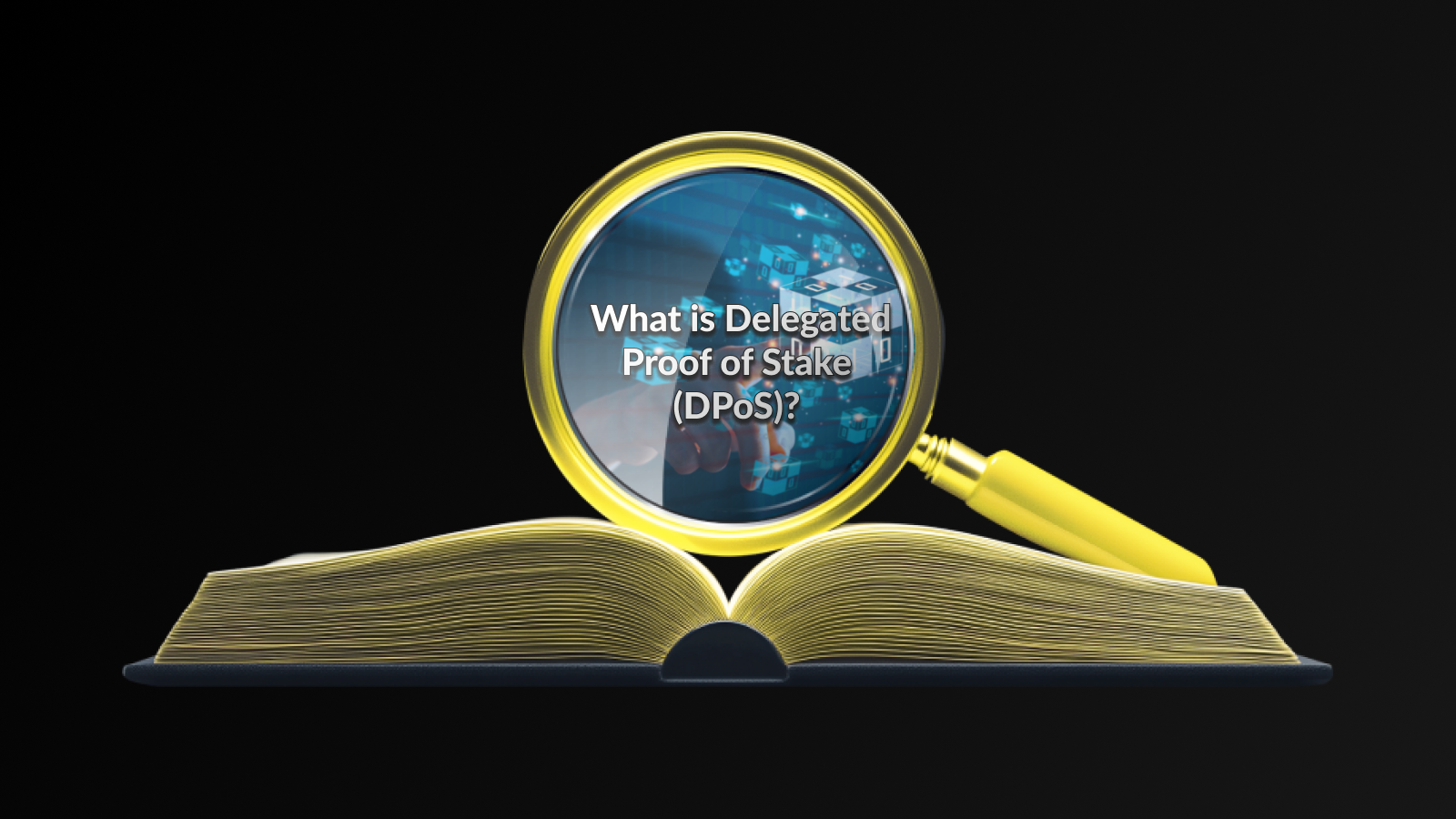Introduction
Blockchain networks require efficient and secure consensus mechanisms to validate transactions and maintain network integrity. One of the most advanced consensus models developed for this purpose is Delegated Proof of Stake (DPoS). DPoS enhances traditional Proof of Stake (PoS) by introducing a voting-based system that enables token holders to elect delegates who validate transactions on their behalf. This system improves scalability, efficiency, and decentralization while ensuring that blockchain networks remain secure and functional.
DPoS is widely used in major blockchain platforms such as EOS, TRON, and Tezos due to its ability to process high transaction volumes with lower energy consumption. This article will explore how DPoS works, its advantages and challenges, and its impact on the future of blockchain technology.
How Does It Work?
Delegated Proof of Stake (DPoS) is a consensus mechanism that enhances traditional Proof of Stake (PoS) by introducing a system of delegation. In DPoS, token holders do not directly participate in the validation of transactions. Instead, they elect a limited number of delegates who are responsible for producing blocks and maintaining the network’s integrity.
The process begins when stakeholders cast their votes to elect delegates, with each token typically representing one vote. This voting mechanism is crucial as it determines which delegates will be responsible for writing the next block on the blockchain. The selected delegates, often referred to as witnesses or validators, take on the responsibility of validating transactions and creating new blocks. In exchange for this, they receive rewards, which can be shared with the voters who elected them, creating an incentive structure that aligns the interests of both parties.
One of the key features of DPoS is its ability to reach consensus more quickly than other mechanisms. The delegation process reduces the number of participants involved in the consensus, which allows for faster block generation and confirmations. This efficiency often results in higher transaction throughput, making DPoS an appealing choice for platforms that aim to scale and manage a large volume of transactions.
Moreover, the system is designed to be more democratic and responsive. If a delegate fails to perform their duties or doesn’t act in the best interest of the network and its participants, they can be replaced through the vote of the token holders. This mechanism encourages delegates to act responsibly and remain engaged with the community, as their continued approval depends on their performance and service to the network.
How Does Delegated Proof of Stake (DPoS) Work?
The Delegated Proof of Stake (DPoS) mechanism operates through a unique process that enhances the traditional Proof of Stake (PoS) model. In a DPoS system, token holders have the power to vote for a select group of delegates, or witnesses, who will be responsible for validating transactions and maintaining the blockchain. This democratic approach allows the community to elect representatives to make decisions on their behalf, creating a more efficient and streamlined consensus process.
Here’s how the DPoS process typically unfolds:
- Voting: Token holders participate in the governance of the network by voting for their preferred delegates using the tokens they possess. Each token usually counts as one vote.
- Delegate Election: A limited number of delegates (often around 21) are elected based on the highest vote counts. These delegates are tasked with the responsibility of processing transactions and securing the network.
- Block Production: The elected delegates take turns producing blocks at predefined intervals. This method ensures that the block creation process is fast and efficient, compared to PoW systems.
- Rewards and Incentives: Delegates earn rewards for their contributions to the network, which they can share with their voters to incentivize participation and voting loyalty.
- Delegate Accountability: Voters can re-evaluate their choices regularly and can choose to vote for different delegates based on their performance, promoting accountability within the system.
This process allows DPoS to achieve a consensus more rapidly while still maintaining a level of decentralization, as token holders are actively involved in the decision-making process. Additionally, the system’s structure helps mitigate issues such as centralization and provides a robust mechanism for governance within the community.
Advantages and Challenges of DPoS
The Delegated Proof of Stake (DPoS) consensus mechanism comes with a range of advantages and challenges that are essential to understand for anyone involved in blockchain technology.
Advantages of DPoS
- Scalability: One of the main benefits of DPoS is its ability to handle a high transaction volume. This is achieved through its unique voting system that allows for faster confirmation times compared to traditional Proof of Stake (PoS) systems.
- Decentralization: Though DPoS utilizes delegates to validate transactions, it still promotes a level of decentralization. Token holders have the power to vote and influence decisions, thereby reducing the risk of central authority.
- Higher Incentives: Delegates in a DPoS system are motivated to maintain the network’s health and performance since they can earn rewards based on their performance and the votes they received.
- Energy Efficiency: Compared to traditional mining methods, DPoS requires significantly less energy to maintain the network, making it a more sustainable option in the long run.
Challenges of DPoS
- Centralization Risks: Despite its intended decentralization, DPoS can lead to centralization if a few delegates become too powerful. This is often referred to as the rich getting richer phenomenon, where wealthy stakeholders can continue to accumulate power.
- Voter Apathy: Voter turnout is crucial for DPoS to function effectively; however, many token holders may not participate actively, leading to a concentration of power in the hands of a few who participate consistently.
- Delegate Abuse: There’s a risk that delegates may act against the interests of their voters, especially if their motives are financially driven. This can arise from conflicts of interest or lack of accountability mechanisms.
Overall, understanding the advantages and challenges of DPoS is essential for participants in the blockchain space, as it enables them to navigate the complexities of this consensus mechanism effectively.
The future of DPoS in blockchain and crypto appears to be promising, as this consensus mechanism continues to evolve and attract attention from developers and users alike. Increasing scalability and efficiency are increasingly prioritized in the ever-growing blockchain landscape, making DPoS an appealing choice for new projects aiming to enhance transaction speeds and reduce costs.
Moreover, the decentralized governance aspect of DPoS presents an opportunity for community engagement and empowerment. As more projects adopt this consensus model, it is likely that we will see innovations in voting systems and stakeholder participation, promoting a fair and transparent decision-making process.
Additionally, the integration of DPoS within existing blockchain platforms could pave the way for interoperability among various networks, facilitating seamless transactions and collaboration across ecosystems. This could further strengthen the utility of DPoS in real-world applications, creating greater value for users and investors.
However, challenges remain, including centralization risks and potential voter apathy, which could undermine the system’s integrity. As developers work to address these concerns, the adoption of better mechanisms to enhance accountability and participation in DPoS will be crucial for its sustained success.
Frequently Asked Questions
What is Delegated Proof of Stake (DPoS)?
Delegated Proof of Stake (DPoS) is a consensus mechanism used by certain blockchain networks where stakeholders vote for a small number of delegates who will validate transactions and secure the network on their behalf.
How does DPoS differ from traditional Proof of Stake (PoS)?
Unlike traditional Proof of Stake, where all validators are chosen based on the amount of cryptocurrency they hold, DPoS introduces a voting system whereby coin holders elect a limited number of delegates to perform the validation tasks.
What are the main benefits of using DPoS?
DPoS offers several benefits, including increased transaction throughput, lower energy consumption compared to Proof of Work (PoW), and enhanced decentralization by empowering community participation in the validation process.
What role do delegates play in a DPoS system?
Delegates in a DPoS system are responsible for validating transactions and maintaining the blockchain. Their performance directly affects the network’s reliability and efficiency, and they can be replaced if they fail to meet community expectations.
How are delegates chosen in DPoS?
Delegates are chosen through a voting process where token holders have the power to cast votes for their preferred candidates. The top-ranked delegates based on the number of votes become the active validators for the network.
Can the DPoS system be considered more democratic? Why or why not?
Yes, DPoS can be considered more democratic as it allows coin holders to have a say in who gets to validate transactions, thus promoting community involvement and governance. However, the system can still be influenced by whale investors who hold large amounts of tokens.
What are some examples of blockchains that utilize DPoS?
Some well-known blockchains that use Delegated Proof of Stake include EOS, Tron, and Bit Shares, each of which has implemented DPoS to improve scalability and governance within their ecosystems.
Disclaimer
This article is for informational purposes only and should not be considered financial, investment, or legal advice. Engaging in blockchain staking and governance involves risks, including market volatility and security vulnerabilities. Always conduct thorough research and consult a financial professional before participating in DPoS-based cryptocurrencies or staking mechanisms.





